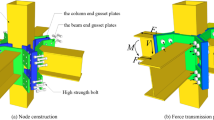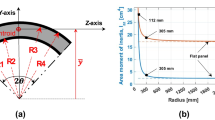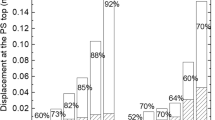Abstract
Inner-reinforced girders, also known as ribs, are widely used in hydropower bifurcations. However, while they strengthen structures, they also cause energy loss. This work aims to develop an appropriate geometry form for ribs that can diminish head loss in hydropower bifurcations. The term rib/breadth ratio (RBR) is defined to describe the geometrical form of ribs. An investigation is conducted to study the flow and performance characteristics of bifurcations with ribs using computational fluid dynamics. The dependence of the head loss coefficient on the RBR is given in six working conditions. Results show that the ribs change the local flow patterns and slightly increase the water head loss in some cases. In other cases, however, the ribs make the flow smooth. An appropriate RBR is the key to improve the flow patterns in hydropower bifurcations. The head loss varies with the RBR and reaches the minimum when the RBR is 0.3.











Similar content being viewed by others
References
Nazari ME, Ardehali MM, Jafari S (2010) Pumped-storage unit commitment with considerations for energy demand, economics, and environmental constraints. Energy 35(10):4092–4101
Ardizzon G, Cavazzini G, Pavesi G (2014) A new generation of small hydro and pumped-hydro power plants: advances and future challenges. Renew Sustain Energy Rev 31:746–761
American Society of Civil Engineers (2012) ASCE manuals and reports on engineering practice no. 79, steel penstocks, 2nd edn. American Society of Civil Engineers
Wu HG, Shi CZ, Su K (2008) Study on structure characteristics of embedded crescent-rib reinforced bifurcated pipe. J Hydraul Eng 39(4):460–465 (in Chinese)
Pérez-García J, Sanmiguel-Rojas E, Hernández-Grau J et al (2006) Numerical and experimental investigations on internal compressible flow at T-type junctions. Exp Therm Fluid Sci 31(1):61–74
Pérez-García J, Sanmiguel-Rojas E, Viedma A (2009) New experimental correlations to characterize compressible flow losses at 90-degree T-junctions. Exp Therm Fluid Sci 33(2):261–266
Pérez-García J, Sanmiguel-Rojas E, Viedma A (2010) New coefficient to characterize energy losses in compressible flow at T-junctions. Appl Math Model 34(12):4289–4305
Gan G, Riffat SB (2000) Numerical determination of energy losses at duct junctions. Appl Energy 67(3):331–340
Tang JL, Wang LW, Li X (2009) Resistance characteristics of hydraulic oil through isodiametric T-type duct with sharp corners. Chin J Mech Eng 22(2):250–255 (in Chinese)
Jeong W, Seong J (2014) Comparison of effects on technical variances of computational fluid dynamics (CFD) software based on finite element and finite volume methods. Int J Mech Sci 78:19–26
Romero-Gomez P, Ho CK, Choi CY (2008) Mixing at cross junctions in water distribution systems. I: numerical study. J Water Resour Plan Manag 134(3):285–294
Austin RG, Waanders BVB, Mckenna S et al (2008) Mixing at cross junctions in water distribution systems. II: experimental study. J Water Resour Plan Manag 134(3):295–302
Liu H, Li P (2013) Even distribution/dividing of single-phase fluids by symmetric bifurcation of flow channels. Int J Heat Fluid Flow 40:165–179
Deane JP, Gallachóir BPÓ, Mckeogh EJ (2010) Techno-economic review of existing and new pumped hydro energy storage plant. Renew Sustain Energy Rev 14(4):1293–1302
Wilcox DC (1993) Turbulence Modeling for CFD. DCW Industries Inc, La Canada
Shih TH, Liou WW, Shabbir A et al (1995) A new k − ε eddy viscosity model for high reynolds number turbulent flows. Comput Fluids 24(3):227–238
ANSYS Inc. (2011) ANSYS FLUENT User’s Guide. Version 14.0. Canonsburg
Ferziger JH, Perić M (2002) Computational methods for fluid dynamics, 3rd edn. Springer, Berlin
Van Doormaal JP, Raithby GD (1984) Enhancements of the SIMPLE method for predicting incompressible fluid flows. Numer Heat Transf 7(2):147–163
Bassett MD, Winterbone DE, Pearson RJ (2001) Calculation of steady flow pressure loss coefficients for pipe junctions. In: Proceedings of the Institution of Mechanical Engineers, Part C: Journal of Mechanical Engineering Science, 215(8): 861–881
White FM (2008) Fluid mechanics, 6th edn. McGraw-Hill, New York
Yang XL, Gao JZ, Liu ZP (2005) Optimal width ratio of crescent rib in bifurcation of pumped storage power station based on numerical simulation of flow. J Hydraul Eng 36(9):1133–1137 (in Chinese)
Kickhofel J, Valori V, Prasser HM (2014) Turbulent penetration in T-junction branch lines with leakage flow. Nucl Eng Des 276(3):43–53
Acknowledgements
This study was supported by the National Natural Science Foundation of China (No. 51679175 and No. 51409194).
Author information
Authors and Affiliations
Corresponding author
Rights and permissions
About this article
Cite this article
Zhang, Z., Wu, H., Wang, Y. et al. Geometrical Design and Hydraulic Feasibility of Inner-Reinforced Girders in Hydropower Bifurcations. Trans. Tianjin Univ. 23, 461–470 (2017). https://doi.org/10.1007/s12209-017-0063-0
Received:
Revised:
Accepted:
Published:
Issue Date:
DOI: https://doi.org/10.1007/s12209-017-0063-0




